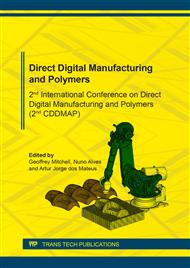[1]
D.J. Hunter, D. Schofield, E. Callander, The individual and socioeconomic impact of osteoarthritis, Nat. Rev. Rheumatol. 10 (2014) 437–441.
DOI: 10.1038/nrrheum.2014.44
Google Scholar
[2]
L.S. Lohmander, Knee replacement for osteoarthritis: facts, hopes, and fears, Medicographia 35 (2013) 181–188.
Google Scholar
[3]
C. Juhl, R. Christensen, E.M. Roos, W. Zhang, H. Lund, Impact of Exercise Type and Dose on Pain and Disability in Knee Osteoarthritis: A Systematic Review and Meta‐Regression Analysis of Randomized Controlled Trials, Arthritis Rheumatol. 66 (2014) 622–636.
DOI: 10.1002/art.38290
Google Scholar
[4]
T. Woodfield, K. Lim, P. Morouço, R. Levato, J. Malda, F. Melchels, Biofabrication in Tissue Engineering, in: Ref. Modul. Mater. Sci. Mater. Eng., (2017).
DOI: 10.1016/b978-0-12-803581-8.10221-8
Google Scholar
[5]
D.W. Hutmacher, Scaffolds in tissue engineering bone and cartilage, Biomaterials 21 (2000) 2529–2543.
DOI: 10.1016/s0142-9612(00)00121-6
Google Scholar
[6]
P.G. Morouço, N.M. Alves, S.C. Amado, The Role of Biomechanics in Tissue Engineering, Austin J Biomed Eng 3 (2016) 1035.
Google Scholar
[7]
J. Malda, J. Visser, F.P. Melchels, T. Jüngst, W.E. Hennink, W.J.A. Dhert, J. Groll, D.W. Hutmacher, 25th anniversary article: engineering hydrogels for biofabrication, Adv. Mater. 25 (2013) 5011–5028.
DOI: 10.1002/adma.201302042
Google Scholar
[8]
D.R. Jeffrey, I. Watt, Imaging hyaline cartilage, Br. J. Radiol. (2014).
Google Scholar
[9]
V.H.M. Mouser, R. Levato, L.J. Bonassar, D.D. D'Lima, D.A. Grande, T.J. Klein, D.B.F. Saris, M. Zenobi-Wong, D. Gawlitta, J. Malda, Three-Dimensional Bioprinting and Its Potential in the Field of Articular Cartilage Regeneration, Cartilage (2016) 1947603516665445.
DOI: 10.1177/1947603516665445
Google Scholar
[10]
M.I. Baker, S.P. Walsh, Z. Schwartz, B.D. Boyan, A review of polyvinyl alcohol and its uses in cartilage and orthopedic applications, J. Biomed. Mater. Res. Part B Appl. Biomater. 100 (2012) 1451–1457.
DOI: 10.1002/jbm.b.32694
Google Scholar
[11]
T.D. Sargeant, A.P. Desai, S. Banerjee, A. Agawu, J.B. Stopek, An in situ forming collagen–PEG hydrogel for tissue regeneration, Acta Biomater. 8 (2012) 124–132.
DOI: 10.1016/j.actbio.2011.07.028
Google Scholar
[12]
H. Shin, B.D. Olsen, A. Khademhosseini, The mechanical properties and cytotoxicity of cell-laden double-network hydrogels based on photocrosslinkable gelatin and gellan gum biomacromolecules, Biomaterials 33 (2012) 3143–3152.
DOI: 10.1016/j.biomaterials.2011.12.050
Google Scholar
[13]
P. Morouço, S. Biscaia, T. Viana, M. Franco, C. Malça, A. Mateus, C. Moura, F.C. Ferreira, G. Mitchell, N.M. Alves, Fabrication of poly(ϵ-caprolactone) scaffolds reinforced with cellulose nanofibers, with and without the addition of hydroxyapatite nanoparticles, Biomed Res. Int. 2016 (2016).
DOI: 10.1155/2016/1596157
Google Scholar
[14]
L. Kock, C.C. van Donkelaar, K. Ito, Tissue engineering of functional articular cartilage: the current status, Cell Tissue Res. 347 (2012) 613–627.
DOI: 10.1007/s00441-011-1243-1
Google Scholar
[15]
A.A. Zadpoor, J. Malda, Additive Manufacturing of Biomaterials, Tissues, and Organs, (2017).
Google Scholar
[16]
Y. Wang, G.A. Ameer, B.J. Sheppard, R. Langer, A tough biodegradable elastomer., Nat. Biotechnol. 20 (2002) 602–606.
DOI: 10.1038/nbt0602-602
Google Scholar
[17]
R.Z. Xiao, Z.W. Zeng, G.L. Zhou, J.J. Wang, F.Z. Li, A.M. Wang, Recent advances in PEG-PLA block copolymer nanoparticles, Int. J. Nanomedicine 5 (2010) 1057–1065.
DOI: 10.2147/ijn.s14912
Google Scholar
[18]
A.K. Gaharwar, M. Nikkhah, S. Sant, A. Khademhosseini, Anisotropic poly (glycerol sebacate)-poly ( ϵ -caprolactone) electrospun fibers promote endothelial cell guidance, Biofabrication 7 (2014) 15001.
DOI: 10.1088/1758-5090/7/1/015001
Google Scholar
[19]
X. Zhao, Y. Wu, Y. Du, X. Chen, B. Lei, Y. Xue, P.X. Ma, A highly bioactive and biodegradable poly(glycerol sebacate)–silica glass hybrid elastomer with tailored mechanical properties for bone tissue regeneration, J. Mater. Chem. B 3 (2015) 3222–3233.
DOI: 10.1039/c4tb01693a
Google Scholar
[20]
S. Sant, D. Iyer, A.K. Gaharwar, A. Patel, A. Khademhosseini, Effect of biodegradation and de novo matrix synthesis on the mechanical properties of valvular interstitial cell-seeded polyglycerol sebacate-polycaprolactone scaffolds, Acta Biomater. 9 (2013) 5963–5973.
DOI: 10.1016/j.actbio.2012.11.014
Google Scholar
[21]
J. Coates, Interpretation of Infrared Spectra, A Practical Approach, Encycl. Anal. Chem. (2006) 1–23.
Google Scholar


